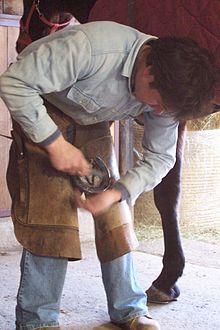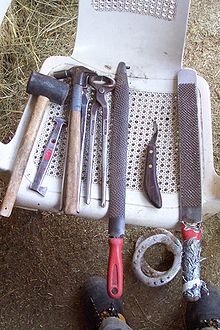Farrier
This article needs additional citations for verification. (October 2009) |



A farrier is a specialist in equine hoof care, including the trimming and balancing of horses' hooves and the placing of shoes on their hooves, if necessary. A farrier combines some blacksmith's skills (fabricating, adapting, and adjusting metal shoes) with some veterinarian's skills (knowledge of the anatomy and physiology of the lower limb) to care for horses' feet.
History and ceremonial
Historically, the jobs of farrier and blacksmith were practically synonymous, shown by the etymology of the word: farrier comes from Middle French: ferrier (blacksmith), from the Latin word ferrum (iron).[1] A farrier's work in colonial America or pre-Industrial Revolution Europe would have included shoeing horses, as well as the fabrication and repair of tools, the forging of architectural pieces, and so on. Modern day farriers usually specialize in horseshoeing, focusing their time and effort on the care of the horse's hoof. For this reason, farriers and blacksmiths are considered to be in separate, albeit related, trades.
In the British Army, the Household Cavalry have farriers who march in parade in ceremonial dress, carrying their historical axes with spikes. They are a familiar sight at the annual Trooping the Colour. There is also a farrier on call "round the clock, twenty-four hours a day, at Hyde Park Barracks."[2]
In the United Kingdom, the Worshipful Company of Farriers is one of the Livery Companies of the City of London. The Farriers, or horseshoe makers, organised in 1356. It received a Royal Charter of incorporation in 1571. Over the years, the Company has evolved from a trade association for horseshoe makers into an organisation for those devoted to equine welfare, including veterinary surgeons.
Work
A farrier's routine work is primarily hoof trimming and shoeing. In ordinary cases, it is important to trim each hoof so it retains its proper orientation to the ground. If the animal has a heavy work load, works on abrasive footing, needs additional traction, or has pathological changes in the hoof, then shoes may be required.
Additional tasks for the farrier include dealing with injured or diseased hooves and application of special shoes for racing, training or "cosmetic" purposes. Horses with certain diseases or injuries may need remedial procedures for their hooves, or need special shoes.
As a service-based industry, farriers must combine technical competence with horsemanship and the ability to deal with clients. Self-employed farriers and those in partnerships may also require skill in running a small business.
Tools used
| Tool | Picture | Function |
|---|---|---|
| Anvil, hammer | 
|
Used to shape horseshoes to fit horse's feet |
| Furnace and tongs | 
|
Used to heat horseshoes to allow custom shaping and specialized design, tongs hold a hot shoe in both the furnace and on the anvil |
| Clinchers | Used to bend over ("clinch") ends of nails to hold the shoe in place | |
| Hammer | Two types, a larger design used on the anvil to shape shoes, a smaller one used to drive nails into hoof wall, through nail holes in shoe | |
| Hoof knife | 
|
Used to trim frog and sole of hoof |
| Hoof nippers | 
|
Used to trim hoof wall[3] |
| Hoof testers | Used to detect cracks, weakness or abscess in the hoof[4] | |
| Rasp | 
|
Used to finish trim and smooth out edges of hoof[5] |
| Stand | 
|
Used to rest a horse's hoof off the ground when rasping the toe area. |
Qualifications
In countries such as the United Kingdom, it is illegal for people other than registered farriers to call themselves a farrier or to carry out any farriery work (in the UK this is under the Farriers (Registration) Act 1975).[6] The primary aim of the Act is to "prevent and avoid suffering by and cruelty to horses arising from the shoeing of horses by unskilled persons".
However, in other countries, such as the United States, farriery is not regulated, no legal certification exists,[7] and qualifications can vary. In the US, three organizations - the American Farrier's Association (AFA); the Guild of Professional Farriers (GPF); and the Brotherhood of Working Farriers (BWFA) maintain voluntary certification programs for farriers. Of these, the AFA's program is the largest with approximately 2800 certified farriers.[citation needed] Additionally, the AFA program has a reciprocity agreement with the Farrier Registration Council and the Worshipful Company of Farriers in the UK.
Within the certification programs offered by the AFA and the GPF, all farrier examinations are conducted by peer panels. The farrier examinations for both organizations are designed so that qualified farriers may obtain a formal credential indicating they meet a meaningful standard of professional competence as determined by technical knowledge and practical skills examinations, length of field experience, and other factors.[8][9] Farriers who have received a certificate of completion for attending a farrier school or course may represent themselves as having completed a particular course of study. Sometimes, usually for purposes of brevity, they use the term "certified" in advertising.
Where professional registration exists, on either a compulsory or voluntary basis, there is often a requirement for continuing professional development activity to maintain a particular license or certification. For instance, farriers voluntarily registered with the American Association of Professional Farriers (AAPF) require at least 16 hours of continuing education every year to maintain their accreditation.[10]
See also
- Equine anatomy
- Equine forelimb anatomy
- Equine podiatry
- Household Cavalry Army Farriers
- Natural hoof care
- Rasp
- Worshipful Company of Farriers
References
- ^ "Farrier" at Etymonline.com
- ^ Household Cavalry Info site, Farriers section. Accessed 20 March 2012.
- ^ "Getting More Out of Your Hoof Nippers".
- ^ "A Valuable Diagnostic Tool When Properly Used".
- ^ "Why Rasps are the Most Important -- Yet Most Neglected -- Tool in your Shoeing Box".
- ^ Farriers (Registration) Act 1975
- ^ "Finding a Farrier".
- ^ "The American Farriers Association". Americanfarriers.org. 2011-04-28. Retrieved 2013-05-11.
- ^ Registration guidelines for The Guild of Professional Farriers
- ^ "AAPF Accreditation".
